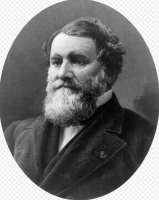










Cyrus Hall McCormick was an Inventor and founder of the McCormick Harvesting Machine Company, which became part of International Harvester Company in 1902.From the Blue Ridge Mountains of Virginia, he and many members of his family became prominent residents of Chicago.
Although McCormick is credited as the "inventor" of the mechanical reaper, he based his work on that of many others, including Roman, Scottish and American men, more than two decades of work by his father, and the aid of Jo Anderson, a slave held by his family.Cyrus McCormick filed patents for the invention, and his achievements were chiefly in the development of a company, marketing and sales force to market his products.
Early life
Cyrus McCormick was born February 15, 1809 in the Shenandoah Valley of Virginia. He was the eldest of eight children born to inventor Robert McCormick, Jr. (1780–1846) and Mary Ann "Polly" Hall (1780–1853). As Cyrus' father saw the potential of the design for a mechanical reaper, he applied for a patent to claim it as his own invention. He worked for 28 years on a horse-drawn mechanical reaper to harvest grain; however, he was never able to reproduce a reliable version.
Cyrus took up the project.He was aided by Jo Anderson, an enslaved African American on the McCormick plantation at the time.A few machines based on a design of Patrick Bell of Scotland (which had not been patented) were available in the United States in these years. The Bell machine was pulled by horses. The McCormick design was pulled by horses and cut the grain to one side of the team.
Cyrus McCormick held one of his first demonstrations of mechanical reaping at the nearby village of Steeles Tavern, Virginia in 1831. He claimed to have developed a final version of the reaper in 18 months. The young McCormick was granted a patent on the reaper on June 21, 1834.
Because the machine could not handle varying conditions, none were sold. The McCormick family worked together on starting a metal smelting business. The panic of 1837 almost caused the family to go into bankruptcy when a partner pulled out. In 1839 McCormick started doing more public demonstrations of the reaper, but local farmers still thought the machine was unreliable. He did sell one in 1840, but none for 1841.
Using the endorsement of his father's first customer for a machine built by McPhetrich, Cyrus continuously attempted to improve the design. He finally sold seven reapers in 1842, 29 in 1843, and 50 in 1844. They were all built manually in the family farm shop. He received a second patent for reaper improvements on January 31, 1845.
As word spread about the reaper, McCormick noticed orders arriving from farther west, where farms tended to be larger. While he was in Washington, DC to get his 1845 patent, he heard about a factory in Brockport, New York, where he contracted to have the machines mass-produced.
In 1847, Cyrus and his brother Leander (1819–1900) moved to Chicago, where they established a factory to build their machines. At the time, other cities in the midwestern United States, such as Cleveland, Ohio, St. Louis, Missouri, and Milwaukee, Wisconsin, were more prosperous. Chicago had no paved streets at the time, but the city had the best water transportation from the east over the Great Lakes for his raw materials, as well as railroad connections to the farther west where his customers would be.
When McCormick tried to renew his patent in 1848, the US Patent Office noted that a similar machine had already been patented by Obed Hussey a few months earlier. McCormick claimed he had really invented his machine in 1831, but the renewal was denied.William Manning of Plainfield, New Jersey had received a patent for his reaper in May 1831, but at the time, Manning was evidently not defending his patent.
McCormick's brother William (1815–1865) moved to Chicago in 1849, and joined the company to take care of financial affairs. The McCormick reaper sold well, partially as a result of savvy and innovative business practices.Their products came onto the market just as the development of railroads offered wide distribution to distant markets. McCormick developed marketing and sales techniques, developing a wide network of salesmen trained to demonstrate operation of the machines in the field.
A company advertisement was a take-off of the Westward the Course of Empire Takes Its Way mural by Emanuel Leutze; it added to the title: "with McCormick Reapers in the Van."
In 1851, McCormick traveled to London to display a reaper at the Crystal Palace Exhibition. He won a gold medal, but his celebration was short-lived after he learned that he had lost a court challenge to Hussey's patent.
Controversy & Success
In 1861, Hussey's patent was extended but McCormick's was not. He decided to seek help from the US Congress to protect his patent.
In 1879, brother Leander changed the name of the company from "Cyrus H. McCormick and Brothers" to "McCormick Harvesting Machine Company".
He wanted to acknowledge the contributions of others in the family to the reaper "invention" and company, especially their father.[5]
McCormick was a benefactor and member of the board of trustees at Washington and Lee University in his native Virginia for the last 20 years of his life.
Death
McCormick died in Chicago on May 13, 1884; he had been handicapped for the last four years of his life due to a stroke causing paralysis of the legs.He was buried in Graceland Cemetery.
The official leadership of the company passed to his eldest son Cyrus Hall McCormick, Jr. The company factories were the site of urban labor strikes that contributed to the Haymarket Square riot in 1886.